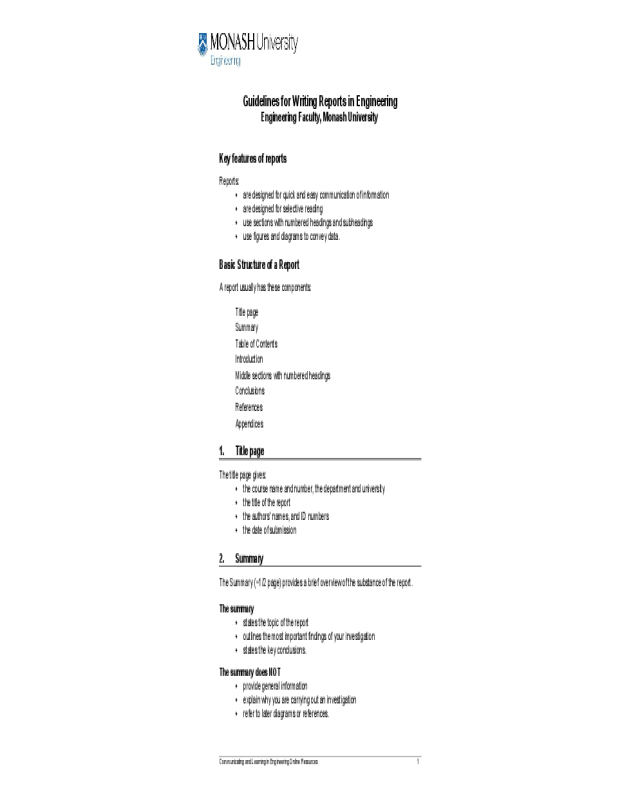Fillable Printable Engineering Report Writing Guidelines
Fillable Printable Engineering Report Writing Guidelines

Engineering Report Writing Guidelines

Communicating and Learning in Engineering Online Resources 1
Guidelines for Writing Reports in Engineering
Engineering Faculty, Monash University
Key features of reports
Reports:
•
are designed for quick and easy communication of information
•
are designed for selective reading
•
use sections with numbered headings and subheadings
•
use figures and diagrams to convey data.
Basic Structure of a Report
A report usually has these components:
Title page
Summary
Table of Contents
Introduction
Middle sections with numbered headings
Conclusions
References
Appendices
1. Title page
The title page gives:
•
the course name and number, the department and university
•
the title of the report
•
the authors' names, and ID numbers
•
the date of submission
2. Summary
The Summary (~1/2 page) provides a brief overview of the substance of the report.
The summary
•
states the topic of the report
•
outlines the most important findings of your investigation
•
states the key conclusions.
The summary does NOT
• provide general information
•
explain why you are carrying out an investigation
•
refer to later diagrams or references.

Example Summary
Summary from a report entitled: Preliminary Design of a Bridge.
Summary
This report presents a design for a bridge to be constructed on the
Calder Freeway crossing Slaty Creek in the Shire of Macedon Ranges.
Two designs for the bridge were devised and then compared by
considering the cost, construction and maintenance of each bridge.
Design 1 is a super-T beam bridge while Design 2 is a simple composite
I girder bridge. It is concluded that Design 1 is the better design. This
design is cheaper, easier to construct, more durable and easier to
maintain.
3. Table of Contents
The table of contents sets out the sections and subsections and their corresponding
page numbers.
•
Number the sections by the decimal point numbering system:
1.0 Title of first main section (usually Introduction)
1.1 First subheading
1.2 Second subheading
2.0 Title of second main section
2.1 First subheading
2.2 Second subheading
2.2.1 First division in the second subheading
2.2.2 Second division in the second subheading
3.0 Title of third main section
•
Number all the preliminary pages in lower-case Roman numerals (i,ii,iii,iv,…).
You don't have to place the number i on the title page. Just count it and put ii on
the second page of your report.
•
Number all the remaining pages of your report with Arabic numerals (1,2,3,4,…).
Thus your report begins on page 1 with your Introduction.
•
Provide a title in your table of contents to describe the contents of each appendix
(Note: one Appendix, two or more Appendices). Don’t just call them Appendix 1 or
Appendix 2.
For example: Appendix 1: Sample Calculations.
Communicating and Learning in Engineering Online Resources 2

Example Contents page
Contents
Summary……………………………………………………...……………. ii
1.0 Introduction.......................................................................................... 1
2.0 Design 1: 33m Steel I-Girder Bridge.................................................... 2
2.1 Superstructure.......................................................................... 2
2.2 Abutments ................................................................................ 3
2.3 Construction method ................................................................ 3
3.0 Design 2: 25m Super T-Girder Bridge ......……………………………… 4
3.1 Superstructure……………………………………………………... 4
3.2 Abutments ………………………………………………………... 5
3.3 Construction method ................................................................ 6
4.0 Comparison of designs........................................................................ 7
4.1 Economics................................................................................ 7
4.1.1 Construction costs .......................................................... 7
4.1.2 Long-term maintenance.................................................. 8
4.2 Safety ....................................................................................... 8
4.3 Aesthetics................................................................................. 9
5.0 Conclusions and Recommendations ................................................... 9
6.0 References ........................................................................................ 10
Appendices:
Appendix 1 Design 1 Scale drawings
Appendix 2 Design 2 Scale drawings
4. Introduction
The introduction (~1/2-3/4 page ) provides the background information needed for the
rest of your report to be understood. It includes:
•
a clear statement of the purpose of the investigation
•
the background of the topic of your report
•
a brief outline of the structure of the report if appropriate (this would not be
necessary in a short report) .
Communicating and Learning in Engineering Online Resources 3

Example Introduction 1
Introduction from a report entitled: Preliminary Design of a Bridge. In this report, two
alternative designs are presented and evaluated according to the given criteria, and
then the better design selected.
Introduction
A dual carriageway bridge with two traffic lanes in each direction is to be
constructed on the Calder Freeway crossing Slaty Creek in the Shire of
Macedon Ranges in Victoria. The bridge is to span 125 metres between
man-made compacted fill embankments, and is approximately 15 metres
above the river surface, with a grade of 0.056 m/m.
This report presents two possible concept designs for this bridge. In
evaluating these designs, the following criteria are considered: the cost
of the bridge, the method of construction, the durability of the bridge and
maintenance considerations, the possible disruption to traffic during
construction and the aesthetics of the bridge.
The two conceptual designs are presented in the form of sketches of the
elevations and cross-sections of the structures.
Example Introduction 2
Introduction from a report entitled: A Review of Greenhouse Gas Reduction Actions
and Opportunities: the Current Status of the Kyoto Protocol.
Introduction
The greenhouse effect is a natural phenomenon that keeps the earth’s
surface warm. Greenhouse gases trap heat from solar radiation,
analogous to the way glass panes trap heat in a greenhouse. Due to
increasing greenhouse gas emissions from human activities, the
greenhouse effect has been significantly augmented, causing a rise in the
earth’s surface temperature. The temperature rise had led to climate
change, causing frequent natural disasters. This has generated increasing
awareness of the importance of reducing greenhouse gas emissions
through international and domestic initiatives.
The aims of this project are to examine the Kyoto Protocol and the effect it
would have on participating countries. Another aim is to investigate
actions already taken by three industrialized countries, namely Australia,
the United States, and Canada.
Communicating and Learning in Engineering Online Resources 4

5. Body of the report
The body of the report
•
presents the information from your research, both real world and
theoretical
•
organises information logically under appropriate headings
•
conveys information in the most effective way for communication:
−
uses figures and tables
−
can use bulleted or numbered lists
−
can use formatting to break up large slabs of text.
Incorporating figures and tables:
•
Refer to each figure and table in the text of the report.
Example:
The communication channels in the organization are shown in Diagram 1.
•
Give all figures a title.
Example:
Table 1 Existing communication channels
•
The title of a table goes above the table while the title of a figure goes below the
figure.
•
Figures must be correctly referenced if necessary. Give the source of the
diagram or the data if you have taken them from published sources.
Incorporating equations:
You will often have to include equations in your reports. The conventional style for
presenting equations is as follows.
1. Centre the equation on the page.
2. Place the equation number in round brackets at the right-hand margin.
3. In the text of your report, refer to the equation as either Eq. (1) or equation (1).
Use whichever format you choose consistently throughout your report.
Example:
The relationship of the speed of propagation and the volumetric tissue
fraction is given by:
v = 1 (1)
√ ((1 – h) K
f
-1
+ h K
t
-1
) ((1- h) ρ
f
+ h ρ
t
)
We can see from Eq. (1) that ……
Communicating and Learning in Engineering Online Resources 5

6. Conclusions
The Conclusion (~1-2 paragraphs) relates directly back to the aims of the
investigation. The Conclusions section provides an effective ending to your report.
This section
• states whether you have achieved the aims of your investigation
•
gives a brief summary of the key information in your report
•
restates the major findings of your investigation.
Example Conclusion
Conclusions from a report entitled: Preliminary Design of a Bridge.
Conclusions
Two designs for the bridge to be constructed on the Calder Freeway across Slaty
Creek have been presented and discussed in this report. Design 1 is a super-T
beam bridge and Design 2 is a simple composite I girder bridge. Both designs
incorporate round piers on piled foundations, which are used because the soil
conditions are unknown and possibly unstable. Design 2 has some advantages
because it is made of steel and thus has longer spans and fewer piers.
However, Design 1 is clearly the better design. This design requires minimal
formwork in the construction of its concrete deck, it is relatively easy to erect and
it maintains stability during transportation and construction. In addition, it is
cheaper to build and more durable
7. References
The two parts to referencing are:
1. citations in the text of the report
2. a list of references in the final section.
Citations show that information comes from another source.
The list of references gives the details of these sources.
You need to use citations in your writing when:
•
you incorporate information from other sources:
−
factual material
−
graphs and tables of data
−
pictures and diagrams
•
you quote word-for-word from another work.
For example, in a lab report when you present the theory in the Introduction you
must include citations which provide the source of this theory.
Communicating and Learning in Engineering Online Resources 6

Example:
The fluid force (lift and drag) occurs on the surface of a moving or a
stationary object placed in a fluid stream (Munson et al. 2006).
Again, in the Discussion you must include citations which provide the source of
specific results from other studies or the standards.
Example:
The present results were similar to those of Dixon who found that the
higher the pitch, the more air that is moved at constant shaft speed
(Dixon 1966).
It is not enough to only list your references in a list at the end of your report.
There are two main systems of referencing commonly used in Engineering, the
author-date (or Harvard) system and the IEEE numbering system. However, you
always have to check whether your lecturer wants you to use a particular system of
referencing in your reports. For example, in Civil Engineering, you are usually
required to use the
author-date referencing system
while in Electrical and
Computer Systems Engineering, you are usually required to a numbering system
called the IEEE referencing system.
Guidelines on the different referencing systems used in Engineering are available in
the section on Referencing in your assignments at:
http://www.eng.monash.edu.au/current-students/comm-learning.html
Bibliography
A bibliography is a list of all the sources that you have consulted while
writing your report, only some of which are cited in the text, so it provides a
wider list of readings than you give in your list of references.
In Engineering reports, you always have to provide a list of references in the
References section. Only occasionally you may also be asked to provide a
bibliography.
8. Appendices
•
These contain material that is too detailed to include in the main report.
•
Each appendix must be referred to at the relevant point in the text.
Example:
The data obtained are summarised below. The detailed data are given in
Appendix 3.
Communicating and Learning in Engineering Online Resources 7

Good reference for report writing:
Silyn-Roberts, H 2002, Writing for Science: A practical handbook for science,
engineering and technology students, 2
nd
edn, Longman, N.Z.
Available from the Hargrave-Andrew Library
(Dewey number 808.0666 R587W 2002).
This reference has excellent sample reports and specific sections of reports.
Communicating and Learning in Engineering Online Resources 8



